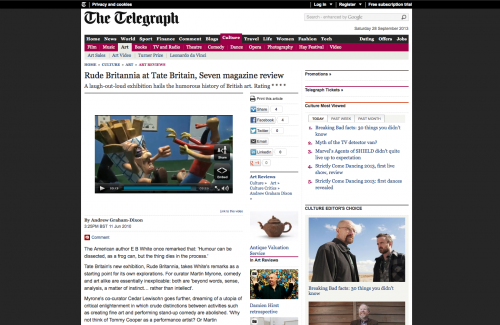All of a Titter at the Tate (Rude Britannia, Tate Britain)
Review by Andrew Graham-Dixon 2010
The American author E B White once remarked that: 'Humour can be dissected, as a frog can, but the thing dies in the process.'
Tate Britain's new exhibition, Rude Britannia, takes White's remarks as a starting point for its own explorations. For curator Martin Myrone, comedy and art alike are essentially inexplicable: both are 'beyond words, sense, analysis, a matter of instinct… rather than intellect'.
Myrone's co-curator Cedar Lewisohn goes further, dreaming of a utopia of critical enlightenment in which crude distinctions between activities such as creating fine art and performing stand-up comedy are abolished. 'Why not think of Tommy Cooper as a performance artist? Or Martin Kippenberger [the late German painter whose pictures often resembled custard pies] as a clown?'
Whatever next? Ricky Gervais for the Turner Prize? Gilbert & George for Best Comedy Performance at the Baftas? Or, maybe, the man is on to something.
For Rude Britannia, Tate Britain's own curators have worked with a number of guest curators drawn from the world of satirists, comic publishers and comedy performers – Gerald Scarfe, Harry Hill, the editors of Viz – to select a screamingly amorphous body of British comic art from the 17th century to the present day.
The exhibition is divided into thematic sections so that Scarfe, for example, presides over a room of satires pullulating with vomitous disgust for politicians past and present – from Gillray's depiction of William Pitt the Younger as public enema number one, sitting astride his cowering nation; to Martin Rowson's Tony Blair, giving evidence at the Iraq inquiry but shown as if morphing into one of the victims of the war he promoted: a yellowed, putrefying corpse, with the powers of speech.
Hill's absurdist room is stuffed with puzzles, provocations and incongruities.
Eighteenth-century satires like Paul Sandby's image of an enormous exploding bottom poised above Portland Square (an allusion to the Georgian craze for hot-air ballooning) coexist with objects trawled from popular culture, such as Flask in the Form of a Potato (1800), a fake terracotta spud designed to allow the 'thirsty' farmworker to indulge his habit without attracting the overseer's attention.
David Shrigley's wide-eyed Dead Cat (2007) occupies a plinth, while clutching a poster with the message 'I'm Dead'. Is this Damien Hirst redone as taxidermical stand-up comedy (its theme is identical to the title of Hirst's original shark in formaldehyde, The Physical Impossibility of Death in the Mind of Someone Living). Or is it Monty Python's 'Dead Parrot' sketch reworked as a piece of conceptual art?
Rude Britannia could have been terrible – many thematic shows are – but it turns out to be inspired, partly because the contemporary and historical art it contains, the supposedly high and the supposedly low, from Hogarth to Benny Hill, speak to each other effortlessly.
One's reminded that the comic and the grotesque constitute virtually the sole continuity in the history of British art.
For centuries the only realm in which the British artist could exert his imagination was comedy. The pattern was set during the Reformation, in the 1530s, when the churches were purged of all their 'high' art (altarpieces; sculptures; images of Christ and Mary), with only the 'low' art (gargoyles) allowed on sufferance to remain.
In the 18th century, Hogarth's comic histories such as The Rake's Progress furnished British art with a grotesque and mass-produced version of the great frescoes of Spain or Italy that Anglicanism had forbidden.
The categorical slipperiness of British creativity even lasted into the 20th century, when our most distinguished Surrealists were the Monty Python team.
Rude Britannia is a vigorous show, which manages to be laugh-out-loud funny and thought-provokingly serious at the same time. Carry on, Tate Britain.
